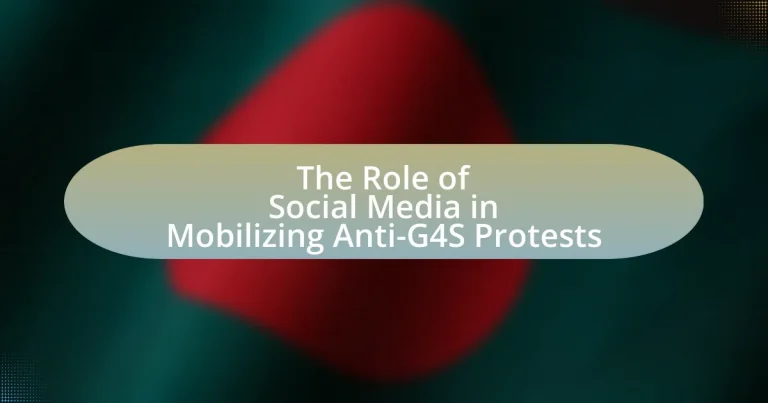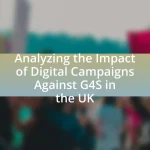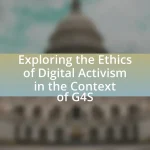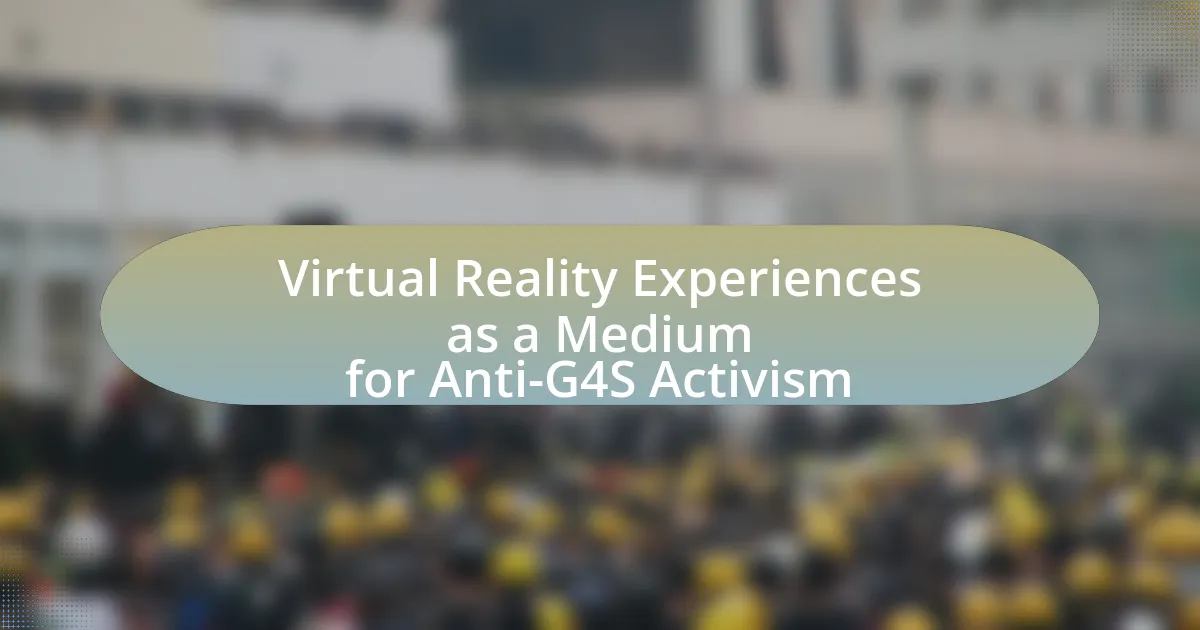The article examines the pivotal role of social media in mobilizing anti-G4S protests, highlighting how platforms like Twitter and Facebook facilitate rapid communication and organization among activists. It discusses the historical influence of social media on protest movements, key features that enhance mobilization, and the specific controversies surrounding G4S that resonate with audiences. Additionally, the article explores strategies employed by activists, the impact of social media on public perception and traditional media coverage, and the challenges faced in mobilization efforts, including misinformation and surveillance. Overall, it provides a comprehensive analysis of how social media shapes collective action against G4S and the broader implications for social movements.
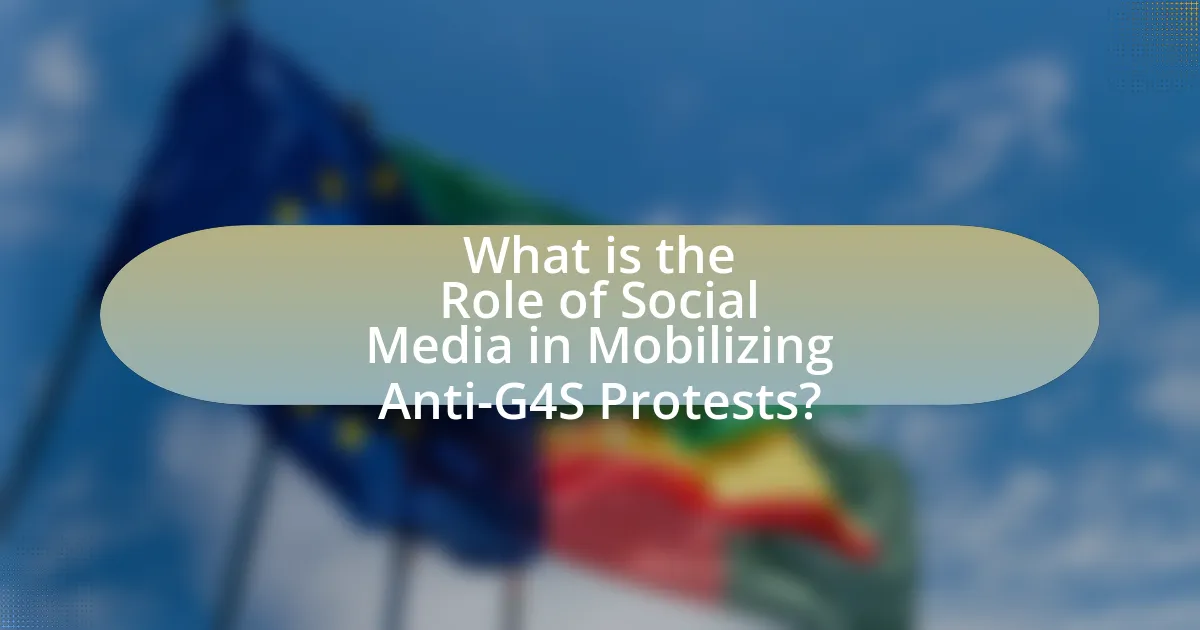
What is the Role of Social Media in Mobilizing Anti-G4S Protests?
Social media plays a crucial role in mobilizing anti-G4S protests by facilitating rapid communication and organization among activists. Platforms like Twitter and Facebook allow users to share information about events, strategies, and grievances related to G4S’s operations, which include controversial practices in security and detention services. For instance, the hashtag #StopG4S has been used to unify voices against the company, leading to coordinated protests and increased public awareness. Research indicates that social media can amplify movements by reaching wider audiences quickly; a study by the Pew Research Center found that 69% of adults in the U.S. use social media, making it an effective tool for grassroots mobilization.
How has social media influenced protest movements historically?
Social media has significantly influenced protest movements historically by facilitating rapid communication and mobilization among activists. For instance, during the Arab Spring in 2010-2011, platforms like Facebook and Twitter enabled protesters to organize demonstrations, share information, and document events in real-time, which contributed to the overthrow of several authoritarian regimes. Additionally, the use of hashtags allowed for the global dissemination of protest messages, increasing awareness and support for movements such as Black Lives Matter, which gained traction through social media campaigns highlighting police brutality. These examples illustrate how social media has transformed the dynamics of protest by enhancing connectivity and amplifying voices that might otherwise remain unheard.
What are the key features of social media that facilitate mobilization?
The key features of social media that facilitate mobilization include rapid information dissemination, community building, and real-time engagement. Rapid information dissemination allows users to share updates and calls to action instantly, which is crucial during protests. For instance, during the Arab Spring, platforms like Twitter enabled activists to organize and inform participants quickly. Community building fosters connections among like-minded individuals, creating a sense of solidarity and shared purpose, as seen in various movements where Facebook groups have united activists. Real-time engagement allows for immediate feedback and coordination, enhancing the effectiveness of mobilization efforts, as demonstrated by the use of live streaming during protests to rally support and document events. These features collectively empower individuals and groups to mobilize effectively for causes such as the anti-G4S protests.
How do social media platforms differ in their impact on protests?
Social media platforms differ in their impact on protests primarily through their audience reach, engagement features, and content dissemination methods. For instance, Twitter facilitates rapid information sharing and real-time updates, which can quickly mobilize participants, as seen during the Arab Spring where tweets played a crucial role in organizing protests. In contrast, Facebook allows for more extensive community building and event organization, enabling users to create detailed event pages that can attract larger groups, exemplified by the Women’s March in 2017, which was largely organized through Facebook events. Additionally, Instagram’s visual-centric approach can amplify the emotional resonance of protests through powerful imagery, influencing public perception and engagement. Each platform’s unique characteristics shape how information is shared and how effectively it can mobilize support for protests.
Why is G4S a focal point for protests?
G4S is a focal point for protests primarily due to its involvement in controversial practices related to immigration detention and security services. The company has faced criticism for its role in operating detention centers that are accused of human rights violations, including inadequate living conditions and mistreatment of detainees. For instance, reports from organizations like Amnesty International have highlighted these issues, leading to public outcry and mobilization against G4S. Additionally, G4S’s contracts with government agencies for security services in conflict zones have drawn scrutiny, further fueling protests organized through social media platforms that amplify calls for accountability and reform.
What controversies surround G4S that lead to public outcry?
G4S has faced significant controversies primarily related to human rights abuses, inadequate treatment of detainees, and involvement in the Israeli-Palestinian conflict, which have led to widespread public outcry. For instance, G4S has been criticized for its role in operating security services in Israeli prisons where reports of torture and mistreatment of Palestinian detainees have emerged. Additionally, the company’s involvement in providing security for the Israeli military has sparked protests and calls for boycotts, particularly from human rights organizations. These controversies have been amplified through social media, mobilizing protests and raising awareness about G4S’s practices globally.
How do these controversies resonate with social media audiences?
Controversies surrounding G4S resonate strongly with social media audiences by amplifying awareness and engagement on issues of human rights and corporate accountability. Social media platforms facilitate rapid dissemination of information, allowing users to share personal stories, news articles, and calls to action related to G4S’s controversial practices. For instance, the widespread sharing of videos and testimonials regarding G4S’s involvement in detention centers has led to increased public scrutiny and mobilization efforts, evidenced by the surge in hashtags and trending topics related to the protests. This engagement is further supported by studies showing that social media can significantly influence public opinion and activism, as seen in the 2020 Black Lives Matter movement, where online discussions translated into real-world protests.
What strategies do activists use on social media to mobilize support?
Activists use various strategies on social media to mobilize support, including targeted messaging, hashtag campaigns, and visual storytelling. Targeted messaging involves crafting specific content that resonates with particular audiences, thereby increasing engagement and support. Hashtag campaigns, such as #BoycottG4S, create a unified call to action that can spread rapidly across platforms, amplifying the movement’s visibility. Visual storytelling, through images and videos, captures attention and evokes emotional responses, making the cause more relatable and urgent. These strategies have been effective in raising awareness and driving participation in protests against G4S, as evidenced by increased online engagement metrics and participation rates in organized events.
What types of content are most effective in engaging audiences?
Visual content, such as videos and infographics, is most effective in engaging audiences. Research indicates that posts with visuals receive 94% more views than those without, highlighting the importance of visual storytelling in capturing attention. Additionally, interactive content, including polls and quizzes, fosters higher engagement rates by encouraging audience participation, as evidenced by a study from Content Marketing Institute showing that interactive content generates twice the engagement of static content.
How do hashtags and trends play a role in protest mobilization?
Hashtags and trends significantly enhance protest mobilization by facilitating communication, raising awareness, and creating a sense of community among participants. For instance, during the Black Lives Matter movement, hashtags like #BlackLivesMatter and #SayHerName not only spread information rapidly but also united individuals across different geographical locations, leading to coordinated protests. Research indicates that social media platforms, particularly Twitter, have been instrumental in amplifying these messages, with studies showing that tweets containing relevant hashtags can increase engagement and participation in protests by up to 30%. This demonstrates that hashtags serve as powerful tools for organizing and mobilizing collective action in social movements.
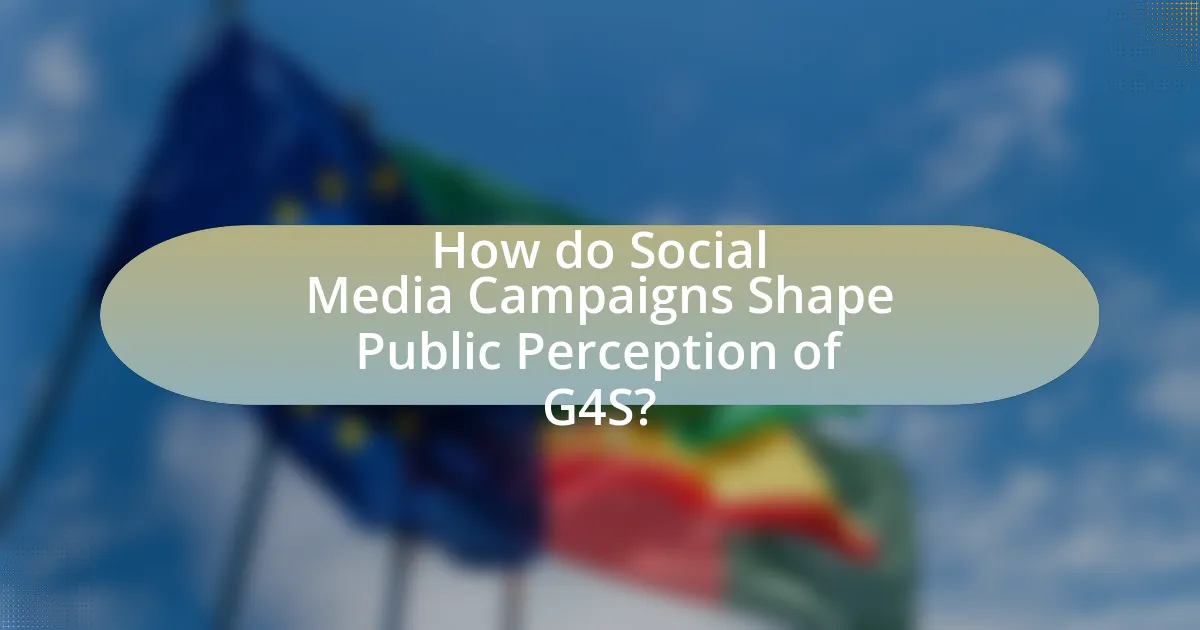
How do Social Media Campaigns Shape Public Perception of G4S?
Social media campaigns significantly shape public perception of G4S by amplifying criticisms and mobilizing collective action against the company. These campaigns utilize platforms like Twitter and Facebook to disseminate information about G4S’s controversial practices, such as its involvement in security operations in conflict zones and allegations of human rights abuses. For instance, the hashtag #BoycottG4S gained traction during protests, leading to increased visibility of the company’s actions and fostering a negative public image. Research indicates that social media can influence public opinion by creating echo chambers where negative sentiments about G4S are reinforced, ultimately affecting its reputation and business operations.
What narratives are constructed around G4S through social media?
Social media constructs narratives around G4S that often highlight its controversial role in security and human rights issues. These narratives frequently focus on allegations of human rights abuses, particularly in relation to G4S’s operations in conflict zones and immigration detention centers. For instance, campaigns on platforms like Twitter and Facebook have amplified criticisms regarding the company’s involvement in the Israeli-Palestinian conflict, portraying G4S as complicit in oppression. Additionally, social media serves as a platform for activists to share personal stories and testimonies, further shaping public perception and mobilizing protests against G4S. The use of hashtags and viral content has been instrumental in uniting various activist groups, thereby reinforcing a collective narrative that challenges G4S’s business practices and ethical standing.
How do these narratives influence public opinion?
Narratives influence public opinion by shaping perceptions and attitudes towards specific issues, such as the anti-G4S protests. Social media platforms amplify these narratives, allowing them to reach a broader audience quickly. For instance, the portrayal of G4S as a controversial entity involved in human rights violations has mobilized public sentiment against the company, leading to increased participation in protests. Research indicates that social media narratives can significantly alter public perceptions; a study by the Pew Research Center found that 64% of Americans believe social media has a major impact on political and social issues. This demonstrates that the narratives surrounding G4S, when disseminated through social media, can effectively sway public opinion and drive collective action.
What role do influencers play in shaping these narratives?
Influencers play a crucial role in shaping narratives surrounding anti-G4S protests by amplifying messages and mobilizing support through their platforms. They leverage their reach and credibility to inform their followers about issues related to G4S, such as human rights violations and corporate accountability. For instance, influencers can share personal stories, statistics, and calls to action that resonate with their audience, thereby increasing awareness and engagement. Research indicates that social media influencers can significantly impact public opinion and activism, as seen in campaigns like #BlackLivesMatter, where influencers helped to spread awareness and drive participation in protests.
How do social media campaigns impact traditional media coverage?
Social media campaigns significantly enhance traditional media coverage by generating real-time engagement and amplifying public interest. When social media users share content related to events, such as protests against G4S, it creates a buzz that traditional media outlets often respond to in order to remain relevant and capture audience attention. For instance, a study by the Pew Research Center found that 62% of journalists reported using social media to discover news stories, indicating that social media serves as a crucial source for traditional media. Additionally, the visibility and virality of social media posts can lead to increased coverage, as seen in various protests where hashtags and trending topics prompted news organizations to report extensively on the events.
What is the relationship between social media buzz and news reporting?
Social media buzz significantly influences news reporting by shaping the narratives and topics that journalists prioritize. When a particular issue gains traction on platforms like Twitter or Facebook, it often prompts news outlets to cover that topic, reflecting public interest and urgency. For instance, during the anti-G4S protests, social media served as a catalyst for news stories, as viral posts and trending hashtags highlighted the movement’s key messages and events, leading to increased media coverage. This relationship illustrates how social media can act as both a source of information and a barometer for newsworthiness, ultimately affecting the agenda-setting process in journalism.
How can social media campaigns lead to increased visibility for protests?
Social media campaigns can lead to increased visibility for protests by rapidly disseminating information and engaging a wider audience. Platforms like Twitter and Facebook allow organizers to share event details, updates, and personal stories, which can go viral and attract attention from users beyond the immediate community. For instance, the #BlackLivesMatter movement gained significant traction through social media, resulting in widespread awareness and participation in protests across various cities. This demonstrates that social media not only amplifies messages but also mobilizes supporters, creating a larger, more visible presence for protests.

What are the Challenges and Limitations of Using Social Media for Mobilization?
The challenges and limitations of using social media for mobilization include misinformation, digital divide, and algorithmic bias. Misinformation can spread rapidly on social media platforms, leading to confusion and undermining the credibility of mobilization efforts. A study by the Pew Research Center found that 64% of Americans believe that misinformation is a major problem on social media. The digital divide creates barriers for marginalized groups who may lack access to technology or the internet, limiting their ability to participate in mobilization efforts. According to the International Telecommunication Union, approximately 3.7 billion people remain unconnected globally, exacerbating inequalities in mobilization. Algorithmic bias can also skew the visibility of posts, favoring certain narratives over others, which can hinder diverse voices from being heard. Research by the MIT Media Lab indicates that misinformation spreads six times faster than factual information on social media, highlighting the significant challenges faced in mobilizing effectively through these platforms.
What risks do activists face when organizing through social media?
Activists face significant risks when organizing through social media, including surveillance, harassment, and misinformation. Surveillance by government agencies or hostile entities can lead to the identification and targeting of activists, as evidenced by reports from organizations like Privacy International, which highlight how social media data can be exploited for monitoring dissent. Harassment, both online and offline, can escalate from coordinated attacks by opposing groups, as seen in various cases where activists have been doxxed or threatened. Additionally, misinformation campaigns can undermine their efforts, as demonstrated during protests where false narratives spread rapidly on social platforms, complicating the activists’ messaging and objectives. These risks create a challenging environment for effective organization and mobilization.
How can surveillance and censorship affect protest mobilization?
Surveillance and censorship can significantly hinder protest mobilization by instilling fear among potential participants and limiting the flow of information. When individuals know they are being monitored, they may hesitate to engage in protests due to concerns about repercussions, such as arrest or social ostracism. For instance, in countries with high levels of surveillance, such as China, the government employs extensive monitoring systems that discourage public dissent and reduce participation in protests. Additionally, censorship restricts access to critical information about protest events, strategies, and solidarity efforts, which can lead to disorganization and decreased turnout. Historical examples, such as the Arab Spring, illustrate how government-imposed internet blackouts and social media restrictions can disrupt communication among activists, ultimately weakening their mobilization efforts.
What are the potential pitfalls of misinformation in social media campaigns?
Misinformation in social media campaigns can lead to significant pitfalls, including the erosion of public trust and the spread of false narratives. When inaccurate information circulates, it can mislead audiences, causing them to form opinions based on incorrect data. For instance, a study by the Pew Research Center found that 64% of Americans believe that misinformation has caused confusion about basic facts regarding important issues. This confusion can result in decreased engagement in legitimate causes, as individuals may become skeptical of all information presented to them. Furthermore, misinformation can polarize communities, leading to increased division and hostility among groups, which undermines the intended goals of social movements like the anti-G4S protests.
How can activists overcome these challenges?
Activists can overcome challenges by leveraging social media to enhance communication, mobilization, and awareness. By utilizing platforms like Twitter, Facebook, and Instagram, activists can disseminate information rapidly, organize events, and engage with a broader audience. For instance, the Arab Spring demonstrated how social media facilitated grassroots movements, allowing activists to coordinate protests and share real-time updates, which significantly increased participation and visibility. Additionally, creating compelling content that resonates with the audience can help in overcoming misinformation and apathy, as seen in various successful campaigns that utilized storytelling and visual media to draw attention to their causes.
What best practices can enhance the effectiveness of social media mobilization?
Effective social media mobilization can be enhanced by utilizing targeted messaging, engaging visuals, and strategic timing. Targeted messaging ensures that content resonates with specific audiences, increasing the likelihood of engagement; for instance, studies show that tailored messages can improve response rates by up to 50%. Engaging visuals, such as infographics and videos, capture attention more effectively than text alone, with research indicating that posts with images receive 94% more views. Strategic timing involves posting when the target audience is most active, which can significantly boost visibility and interaction; data suggests that posts made during peak hours can increase engagement by 20-30%.
How can activists build resilience against online threats?
Activists can build resilience against online threats by implementing robust digital security practices, such as using encrypted communication tools and regularly updating software to protect against vulnerabilities. Research indicates that activists who adopt these measures are better equipped to safeguard their information and maintain operational security. For instance, a study by the Electronic Frontier Foundation highlights that using tools like Signal for messaging and VPNs for internet access significantly reduces the risk of surveillance and hacking. Additionally, training in cybersecurity awareness can empower activists to recognize and respond to potential threats effectively.
What are the key takeaways for effective social media mobilization in protests?
Effective social media mobilization in protests requires clear messaging, strategic use of hashtags, and timely engagement with followers. Clear messaging ensures that the purpose and goals of the protest are easily understood, which can increase participation; for instance, the Black Lives Matter movement effectively used concise slogans to communicate its objectives. Strategic use of hashtags can amplify reach and create a sense of community among supporters, as seen with the #MeToo movement, which connected individuals across various platforms. Timely engagement with followers, including responding to comments and sharing updates, fosters a sense of urgency and encourages real-time participation, demonstrated during the Arab Spring, where social media was pivotal in organizing protests.
